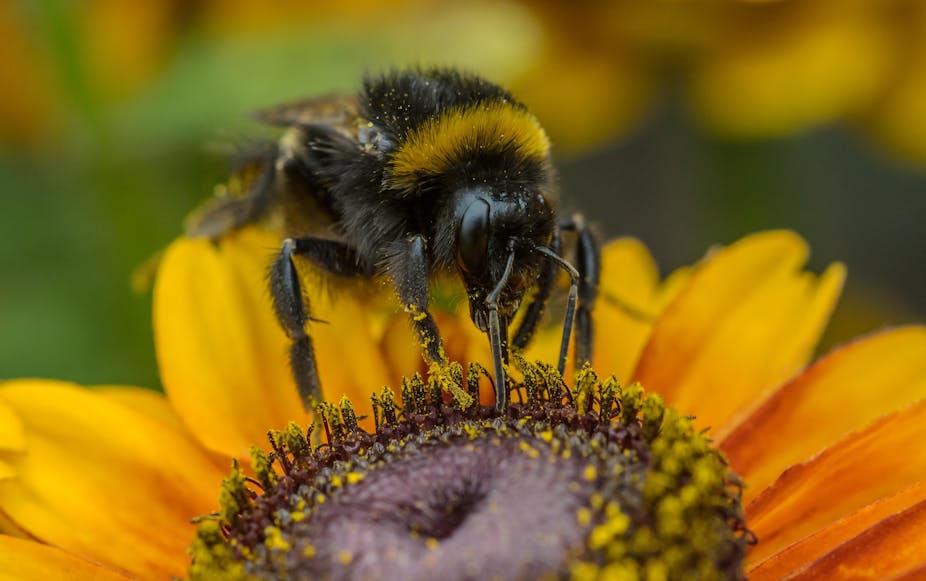In September 1962, American author and conservationist Rachel Carson published Silent Spring. The book’s shocking portrayal of the lethal consequences of the infamous pesticides, such as DDT (dichlorodiphenyltrichloroethane), sparked nationwide outrage and was instrumental in its banning. But recent research from colleagues at Royal Holloway and I shows that almost 60 years on, regulators still haven’t learnt their lessons – and are still approving potentially harmful pesticides that threaten the wildlife on which healthy crops rely.
Silent Spring begins with a tale of a fictional village in America that has been ravaged by agricultural insecticides. Carson vividly describes a “strange stillness” as feeding stations once commonly visited by garden birds now lie deserted, and blooming apple trees that no longer receive frequent visits from bees. The book gives numerous examples of how this fictional village was becoming a reality across the world, and highlighted how exposure to then widely used DDT could be fatal for birds, fish and insects – and as a result, threaten many of our food systems.
Carson’s elegant, convincing and urgent portrayal of how this and similar pesticides were influencing our environment shook people and governments into action. The chemicals were banned across the world, and pesticide companies are now required to rigorously demonstrate that licensed chemicals do not have lethal consequences for wildlife.

Agriculture still required crop protection though, and in the early 1990s neonicotinoid insecticides arrived. Neonicotinoids – or neonics, as they are commonly known – are extremely helpful for farmers. Neonics can be used as a seed coating and will afford the whole plant protection throughout its life, reducing the number of spray treatments crops require and lowering any risks to humans and vertebrate wildlife.
Neonics are now the most commonly used insecticide group in the world – but while they’re an improvement on DDT, they’re by no means harmless. Because they protect the whole plant, they also contaminate the nectar and pollen of treated crops and wildflowers.
A decade of research subsequently demonstrated that neonics can negatively affect bee foraging, learning, memory, brood care, larval development and egg laying. Whilst these effects are not lethal, they can have subtle, but significant impacts on the health on individual bees, which in the case of social bees, such as bumblebees, can severely impair colony health.
As a result, in 2018 the European Union banned the outdoor agricultural use of three common neonics that are known to harm bees, and other pollinators.
However, the requirement for a pesticide that affords whole-plant protection remained strong and a few years ago, a new pesticide called sulfoxaflor became the latest attempt to address that need. With a similar action to neonics, it has now been licensed for use in more than 80 countries around the world - including many that still allow the use of neonics.
Unfortunately, in 2018 colleagues at Royal Holloway and I found evidence that sulfoxaflor exposure can reduce the number of males and queens produced by bumblebee colonies by up to 54%. This research, published in Nature, demonstrated for the first time that sulfoxaflor can have negative impacts on bumblebees.

Now, our most recent research has demonstrated that sulfoxaflor exposure can reduce egg laying by up to 31%, even at the low levels of exposure that bumblebees could experience within agricultural environments. These results are yet to be replicated in the wild, but the evidence suggests that sulfoxaflor could be just as harmful to pollinators as neonicotinoids.
So after two previous high-profile regulatory failures how did sulfoxaflor get licensed for use without a true understanding of its potential impact on pollinators?
When neonics were first licensed for agricultural use we weren’t aware of the harm they caused, because while the fallout from DDT required producers to rigorously demonstrate that insecticides do not have lethal effects before being licensed, the same was not true for many “sublethal” effects. That is, harms that aren’t fatal in themselves, but can still severely compromise the health of a species or ecosystem.
Read more: Pesticide safety research shouldn't be left to the chemical companies that make them
To this day, insecticides can still be licensed without their potential sublethal impacts on pollinators being fully assessed. Testing is limited, and only tends to happen later in the regulatory process – by which time chemicals might already be in use. Furthermore, if toxicity experiments at the start of the regulatory process suggest that a chemical is not lethal to bees, then assessments of sublethal effects might not take place at all.
What’s more, of the assessments that are carried out, most only test honeybees. Little attention is paid to other wild pollinators such as bumblebees and solitary bees, which are also vital in supporting healthy ecosystems and ensuring that crops continue to yield food.
Sulfoxaflor is just one newly emerging insecticide that is being licensed for use, and others may also have sublethal impacts that aren’t fully understood. In order to truly protect wildlife and safeguard pollination, regulators and policy makers must learn from our recent history and consider the potential sublethal consequences of insecticides on pollinators by default – before licences are granted. Failure to do so could result in another “silent spring” – and if the images evoked by Carson are anything to go by, that won’t be good news for anyone.


